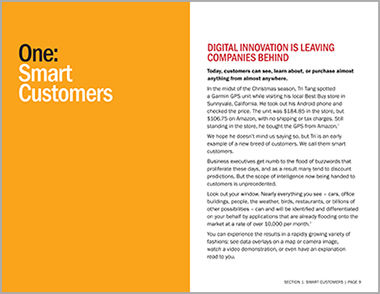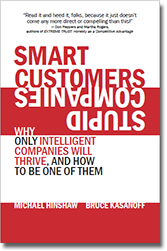Why it is so hard to see the world as it isLinkedIn, November 7, 2012The toughest challenge is seeing the world as it actually is, instead of how we want it to be. Once again, Nate Silver has shown that if you take your own biases out of the equation, the right equation works extremely well. Smart lesson = we crave human contactLinkedIn, November 5, 2012An utterly automated operation will never be able to fully accomodate human needs. No amount of programming can replace the ability of people to connect to each other. We need computers and sensors to do the brute force lifting, to monitor billions of data points and sort through them. But we need people to make people feel truly alive and inspired. [Read More...] InfoComm 100: Ride The Smart Building WaveCommercial Integrator, October 16, 2012This year's InfoComm100 opened with an entertaining and enlightening presentation by Bruce Kasanoff, business consultant and co-author of “Smart Customers, Stupid Companies”, who focused on building strong customer relations and taking advantage of megatrends. Among the many valuable insights he shared, Kasanoff addressed the rapid proliferation of sensor technology and the impact it will have on buildings of the future. He used the iPhone as an example of sensor density, with proximity, light and sound sensors, two cameras, accelerometers, GPS, BlueTooth, and WiFi, in addition to simple cellular. Imagine when the building can tell you that people in your meeting are bored, just by taking advantage of sensors that are already included in many technology-enabled rooms? Microphones, cameras and WiFi can all be used as sensors to aid in understanding human behavior and its situational relevance. 'Smart' in the future means pervasively tracking, remembering and sharing important sensor-based information, and projections indicate that this opportunity is enormous. [Read More...] Why Offering Discounts May Be a Major MistakeIntuit Small Business Blog, October 8, 2012“When you sell products based on price, you are always at the mercy of your dumbest competitor,” says Bruce Kasanoff, co-author of Smart Customers, Stupid Companies. “Anyone stupid enough to lower prices too far will put pressure on you to do the same.” A protracted price war can put you out of business if you end up selling at a loss simply to keep up with the competition. For that reason, Kasanoff is not a fan of using daily-deal sites to generate sales: “They encourage small businesses to commit pricing suicide,” he says. A better bet is to tailor pricing to customers – or groups of customers – based on their specific needs, rather than pushing a one-size-fits-all approach. Drive Customer Loyalty With the 80/20 RuleOpen Forum, September 26, 2012By rewarding your top-performing customers, you’re enhancing customer loyalty and securing continued business from those customers who are providing the bulk of your income. Bruce Kasanoff, founder of Sense of the Future and co-author of Smart Customers, Stupid Companies, recommends allowing customers to create a wish list of products they want and the prices they'd be willing to pay for those items. When it's feasible, offer these products and prices as a reward for customer loyalty. “First, a wish list lets you buy inventory with more confidence, knowing how many items and for what prices you can clear inventory at the end of the season. Second, it encourages customers to tell you what they like. Third, it rewards customers for their feedback,” Kasanoff explains. Using creative strategies like a customer wish list not only helps you nurture your relationships with your best customers, but provides you with useful information you can use to enhance your overall business strategy. [Read More...] Four disruptive technologies to cash in on before it's too lateDigital Trends, August 6, 2012Whether you're a budding entrepreneur or just looking to get ahead at your current job, keeping an eye on these four technologies will put you ahead of the curve. Disruptive technologies may unsettle industry leaders, but they are a potential pot of gold for individuals who shift their careers to leverage these powerful new forces... [Read More...] 6 Steps To A More Mindful Company CultureFast Company, August 2, 2012“Mindful” is not a word typically associated with business—but it should be. A mindful corporate culture will value substance over style, and stress single-minded focus over multi-tasking. Most importantly, it will focus on sensing and responding to what customers are doing right now. Think a bit outside of the box and consider the type of corporate culture that can consistently create and support world-class customer experiences. Try to imagine a mindful approach to customer experience. [Read More...] Interview with Bruce KasanoffThe Pulse on Business, July 19, 2012Butch Stearns sits down with Bruce Kasanoff, president of Now Possible and co-author of the book Smart Customers Stupid Companies, to learn how companies can be “smart” by increasing their flexibility and connecting with and listening to their customers. Bruce highlights five indicators that distinguish “smart” and “stupid” companies, two of which specify that companies should avoid spamming customers, and that they should never close by supplying online ordering systems, mobile apps and 24/7 customer assistance. Sensors Are About To Disrupt Your IndustryFast Company, July 16, 2012Do you really think your existing business model can remain unchanged as nearly every object on the planet acquires the ability to sense its surroundings, relentlessly gathering exabytes of data about everything? Companies that think like a startup will discover huge opportunities; the ability to leverage these forces will dramatically expand the possibilities for start-ups and–more relevant for established companies–for entrepreneurial, start-up thinking. [Read More...] Online Merchants Wrestle With The 'Creepy' Factor In Web PersonalizationReadWriteWeb, June 28, 2012The problem facing retailers trying to personalize a website comes down to how the company collects its information, Bruce Kasanoff, co-author of “Smart Customers, Stupid Companies: Why Only Intelligent Companies Thrive, And How To Be One Of Them,” said in an interview with ReadWriteWeb. “Implicit” makes assumptions about what you do on the Web - someone who checks Boston Red Sox scores each day and reads articles about the team is probably a fan - whereas “explicit” makes assumptions based on specific inputs (I like the Boston Red Sox). “Generally speaking, explicit works better, but participation rates go way down when sites require explicit personalization,” Kasanoff said. The big winner when it comes to gathering explicit information? [Read More...] Dear LinkedIn (and Facebook and Google): It's My Life. Isn't It My Data?The Huffington Post, June 14, 2012Yesterday, I received three identical emails appearing to be from LinkedIn, exhorting me to "click here" to change my password. This worried me for many reasons, not least of which is that I -- along with about 160 million other professionals -- entrust the firm with my data, and it appears they've lost some of it. After all, if these really are from LinkedIn, they waited five days to recommend I reset my password, suggesting they're more worried about potential fallout than my data. Nor did they say a word about their massive security breach -- losing upwards of six million user passwords due to what is widely considered criminally weak cyber-security -- leaving it to me to figure out the broader implications. [Read More...] Banks Still Sticking Flummoxed Customers With Frustrating FeesE-Commerce Times, June 12, 2012"For almost 15 years, banks have been giving lip service to CRM, but not actually doing much of substance to make life easier for their customers," said Bruce Kasanoff, co-author of Smart Customers, Stupid Companies "Lately, they've actually gone in the opposite direction, sneaking in new fees wherever possible, in an effort to boost their profitability." Banks have still not made important reforms or improvements in their checking account practices, according to an update Pew Charitable Trusts made to a report it released in April 2011, "Hidden Risks: The Case for Safe and Transparent Checking Accounts." The original report set out a discouraging list of banking practices that added fees to consumer accounts -- fees that were not necessarily easy to identify beforehand and thus avoid. [Read More...] How Not to Treat Your CustomersTime, June 8, 2012Let’s face it, if you’re an unhappy customer, it’s a lot easier to take your business elsewhere these days. So one of your top priorities as a small business should be to make sure your customers don’t have a reason to shop around. Between the Internet, social media and mobile devices, it’s never been easier to lose a customer if they have a bad experience, whether the reason is price, product quality or customer service. Companies have been slow to respond to the growing sophistication of consumers, say Michael Hinshaw and Bruce Kasanoff, authors of “Smart Customers (Stupid Companies): Why Only Intelligent Companies Will Thrive, and How to Be One of Them.” Hinshaw and Kasanoff offer a number of suggestions for retaining customers – and for how not to treat them. For starters, your customer experience should be unified and easy to navigate, not a confusing maze. [Read More...] Disruptive Innovation Made EasyHarvard Business Review, June 7, 2012On Fast Company's website, Bruce Kasanoff and Michael Hinshaw offer a nifty little primer for prospective disruptors. Looking to take an unsuspecting industry by storm? To start, try eliminating customer pain points. "Each industry has practices that drive customers crazy," write the authors of Smart Customers, Stupid Companies. Take technology providers' technical support, with its long hold times "hopelessly complex interactions." Is there something companies in your industry do that's just as stupid? "Identify these types of practices, and wipe them out." Or you could completely undercut industry pricing models by, say, 90%. "Incremental change doesn’t disrupt an industry; radical change does," they note. You don’t cut prices by 90% through marginal improvements in existing products. You do it by asking, what customer problem are we trying to solve, and how do we solve it in a far more efficient manner? If such radical price competition seems far-fetched, consider how smartphone and iPhone apps have cut the legs out from under numerous incumbents, like GPS manufacturers. Looking for more? The authors offer up five additional strategies... [Read More...] 7 Ways To Disrupt Your IndustryFast Company, June 4, 2012Massive disruption is coming, and the only question is whether your firm is going to cause it or fall victim to it. Disruption is not easy--either to create or to confront. We have no illusions about that. But in the spirit of helping established firms best serve their customers, we offer seven ways your firm could disrupt its own industry, raising the standards of customer experience and creating new opportunities for growth: 1) Totally eliminate your industry’s persistent customer pain points. Each industry has practices that drive customers crazy. Technology providers drive customers crazy with technical support that often requires long waits on hold and hopelessly complex interactions (“Just find the serial number on the back of your device and type that into the space provided along with your IP address and the exact wording of the error message you encountered”). Unsurprisingly, this is the exact type of practice that causes customers to believe a company is behaving stupidly. What practices exist in your industry that drive customers crazy? How do all companies in your industry behave stupidly? Identify these types of practices, and wipe them out. [Read More...] Bruce Kasanoff Interview with Paul MillerWPHM-AM Detroit, June 1, 2012Smart Customers, Stupid Companies: Why Only Intelligent Companies Will Thrive, and How To Be One of Them. |
Buy the book »SHAREMedia Contacts:To interview the authors or to write about Michael, Bruce and Smart Customers Stupid Companies, please contact: Bruce Kasanoff |

Download Chapter One:

How smart are your customers? If your company is like most, they’re likely smarter than you realize. How smart, you ask?
You’ll want to download Chapter One to find out...
Enter your email address below to download this free chapter from the book:
READ AN EXCERPT:
It is not a sustainable strategy to act dumber than the customers you wish to serve.
At the same time, everything and everyone has become or is becoming interconnected. Customers have smartphones loaded with apps that let them check prices, compare service agreements, read reviews, and check in with friends (and strangers) even as they examine your offers and products, and those of your competitors.
Consumers and businesses alike research, connect, and purchase online and over their phones without a second thought.
With these tools come radically higher customer expectations. Higher expectations of experience. Greater demands for personalization and customization. Lower tolerance for mistakes, for running through inane hoops, or for interactions that require mindless repetition (“... What is your account number ...?”).
In short, the world has changed dramatically, but many companies have not. Forget about innovation, they’re not even sure how to keep up. This is the challenge that your company needs to confront.
Companies that can’t pass basic tests of memory, flexibility, responsiveness, and innovation will die.
Among the many disruptive forces that are making it impossible for firms to survive with outdated strategies, four in particular are changing the basic ground rules for business competition and are the focus of this book: Social Influence; Pervasive Memory; Digital Sensors and The Physical Web.
Together, these forces will bring customers more choices, better information, and stunning new services. They are already providing individuals with tools more advanced in many cases than the most sophisticated commercial enterprises had just five years ago.
Put another way, they’ll continue to make your customers even smarter.
We’re just at the tip of this revolution.
For reasons that will become crystal clear as you read this book, established firms will need to reinvent themselves and disrupt their own industries to stay alive. With thousands upon thousands of very bright developers and entrepreneurs working around the globe to provide your customers with ever better, ever more disruptive tools, it’s a certainty that innovation will be coming to your industry if it hasn’t already.
Those companies who react slowly or tentatively will be increasingly marginalized, until finally, they’ll wither away. It may take five, ten, or even fifteen years, but eventually, these companies will be smothered by the competition and the growing demands of their ever-smarter customers.

Table of Contents
|
INTRODUCTION We are not talking about trivial change ONE: SMART CUSTOMERS Digital innovation is leaving companies behind Customers start gaining superhero powers Companies can’t be competitive if they can’t Smart customers expect smart customer experiences Key Takeaways TWO: INTELLIGENCE IS EVERYWHERE Beyond 1to1 to 1toEverything Identify anything, anywhere, anytime A framework for infinite opportunity and innovation Innovators look through the eyes of their customers What your customers could do with a pair of smart glasses Technology is magic your customers need to trust Key Takeaways THREE: A PERFECT STORM OF The four disruptive forces Disruptive force number one: Social Influence Disruptive force number two: Pervasive Memory Disruptive force number three: Digital Sensors Disruptive force number four: the Physical Web Disruption favors the smart customer Key Takeaways FOUR: STUPID COMPANIES Does your company behave stupidly? What happens when smart customers meet Why CRM hasn't helped Does this mean the end of loyalty? Many managers don't care – and aren't paid to Guess what? Your customers don’t care either Dumb touchpoints anchor your performance to the past Key Takeaways FIVE: GET SMART A five-step system for acting smart and growing faster Getting smart: a simple system you can use Segment your customers by needs and value Modularize your capabilities to increase your flexibility Anticipate your customers' needs Reward your employees for win/win behaviors Transform touchpoints (and make them smart) In summary: It really pays to get – and act – smart Key Takeaways SIX: CRITICAL STEPS “If anyone disrupts this industry, it's going to be us.” Welcome to simultaneous change Be smart enough to learn what your customers really need Start making your company smarter, now Key Takeaways AUTHORS Acknowledgements Michael Hinshaw Bruce Kasanoff INDEX SOURCES |
1
9 12 16 26 33
35 37 39 42 44 48 51 53 56 64 69 76 81 85
87 88 92 96 99 104 108 117
119 120 122 126 132 136 140 144 145
147 166 168 171 173
175 176 177 179 183 |

 For Print/Online:
For Print/Online:


